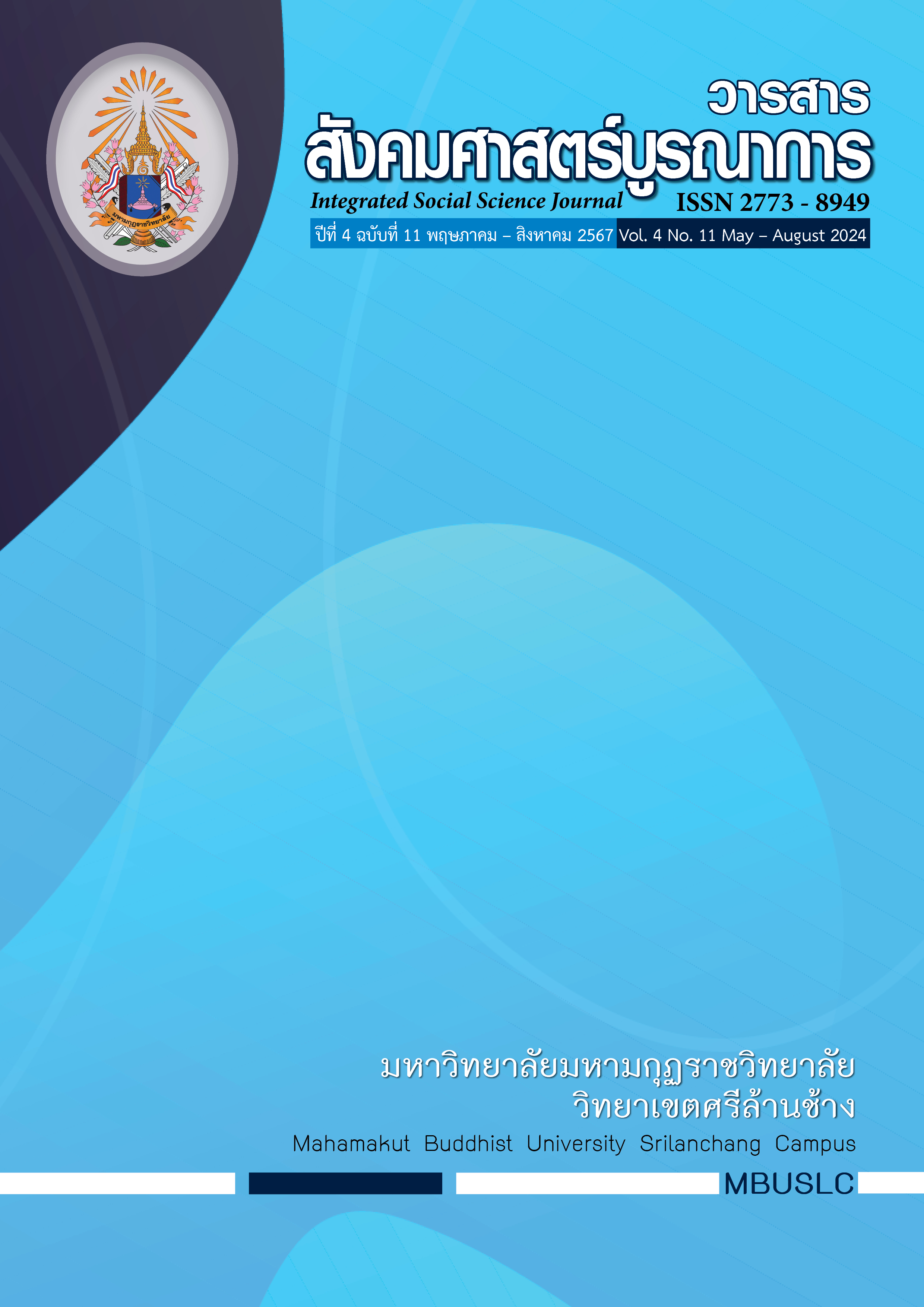STRATEGIES FOR MANAGING TUTORIAL SCHOOLS IN KUNMING, YUNNAN PROVINCE, CHINA
Main Article Content
Abstract
The objectives of this research was to study the current conditions,desirable conditions, and the necessity of strategies for managing tutorial schools in Kunming, Yunnan Province, and to propose administration and strategies for managing tutorial schools in Kunming, Yunnan Province. The population used in this research consists of administrators and staff from 39 tutoring schools in Kunming, with purposive sampling from large tutoring schools, resulting in a sample size of 175 people. The research instrument used was a 5-point Likert scale questionnaire. The statistics used in this study include percentage, frequency, mean, standard deviation, PNIModified analysis, SWOT analysis, and TOWS Matrix.
The study results revealed that: 1) The current and desirable conditions of strategies for managing tutorial schools in Kunming, Yunnan Province, are at a high level. The marketing promotion aspect had the highest average score, followed by the pricing aspect, and the product aspect ranked last. The PNI Modified analysis showed that the personnel aspect had the highest need, followed by the distribution channels aspect, and the marketing promotion aspect had the least need. 2) The proposed strategies for managing tutorial schools in Kunming, Yunnan Province, include having unique and distinctive course content, setting prices appropriate to the level of service, having classrooms of suitable size with internet access, communicating with parents and students to influence their attitudes and service usage behavior, and having staff to provide various information services to students.
Article Details

This work is licensed under a Creative Commons Attribution-NonCommercial-NoDerivatives 4.0 International License.
บทความที่ได้รับการพิจารณาจากคณะกรรมการผู้ทรงคุณวุฒิและเผยแผ่ในวารสารฉบับนี้ เป็นทัศนคติและข้อคิดเห็นส่วนบุคคลของผู้เขียนแต่ละท่าน ไม่ถือว่าเป็นทัศนะคติและความรับผิดชอบ
ของบรรณาธิการ
บทความ ข้อมูล เนื้อหา รูปภาพ ฯลฯ ที่ได้รับการตีพิมพ์ในวารสารสังคมศาสตร์บูรณาการ ถือเป็นลิขสิทธิ์ของวารสารสังคมศาสตร์บูรณาการ หากบุคคลหรือหน่วยงานใดต้องการนำทั้งหมดหรือส่วนหนึ่งส่วนใดไปเผยแพร่ต่อหรือเพื่อกระทำการใด ๆ จะต้องได้รับอนุญาตเป็นลายลักอักษรจากวารสารสังคมศาสตร์บูรณาการ ก่อนเท่านั้น
References
กรกฤช ศรีวิชัย และจรัญญา เทพพรบัญชากิจ. (2566). กลยุทธ์การบริหารโรงเรียนกวดวิชาเพื่อการจัดการเรียนรู้ของผู้เรียน. วารสารวิจัยมหาวิทยาลัยเวสเทิร์น มนุษยศาสตร์และสังคมศาสตร์. 9(3). (กันยายน-ธันวาคม). 15-28.
กิตติวรรณ จุฬานุตรกุล. (2562). พฤติกรรมผู้บริโภคในการตัดสินใจซื้อคอร์สเรียนกวดวิชาของกลุ่มนิสิต-นักศึกษามหาวิทยาลัย. วิทยานิพนธ์วิทยาศาสตรมหาบัณฑิต (การบริหารการตลาด). มหาวิทยาลัยธรรมศาสตร์.
ณธร บุญคล่อง. (2562). ปัจจัยที่มีอิทธิพลต่อการตัดสินใจของผู้ปกครองในการให้บุตรศึกษาในโรงเรียนกวดวิชาภาษาตะวันออกในเขตอำเภอเมือง จังหวัดนครศรีธรรมราช. สารนิพนธ์เศรษศาสตรมหาบัณฑิต. มหาวิทยาลัยเชียงใหม่.
ดิเรก วรรณเศียร. (2567). MACRO model: รูปแบบการจัดการเรียนรู้สำหรับศตวรรษที่ 21. ออนไลน์. สืบค้นเมื่อ 14 กุมภาพันธ์ 2567. แหล่งสืบค้น http://anyflip.com/iuaa/elyg/basic
เทพศักดิ์ บุณยรัตพันธุ์. (2563). SWOT Analysis and TOWS. ออนไลน์. สืบค้นเมื่อ 16 กุมภาพันธ์ 2567. แหล่งสืบค้น www.drmanage.com/index.php?lay=show&ac=article&Id=538632242
นิติบดี ศุขเจริญ และวัยวุฑฒ์ อยู่ในศิล. (2557). การวิเคราะห์อภิมานและการสังเคราะห์อภิมาน. วารสารมหาวิทยาลัยราชภัฏมหาสารคาม. 8(3). (กันยายน-ธันวาคม). 43-56.
ประสูติ อุดมสุข. (2563). ปัจจัยที่มีผลต่อการตัดสินใจเลือกโรงเรียนกวดวิชาของนักเรียนระดับมัธยมศึกษาตอนปลายในจังหวัดปราจีนบุรี. วิทยานิพนธ์วิทยาศาสตรมหาบัณฑิต (การบริหารการตลาด). มหาวิทยาลัยธรรมศาสตร์.
ปรางทิพย์ ตินนะศรี และธนกร สิริสุคันธา. (2565). ส่วนประสมทางการตลาดบริการที่มีอิทธิพลต่อการตัดสินใจเรียนโรงเรียนกวดวิชาของนักเรียน ระดับชั้นมัธยมศึกษาตอนปลาย ในอำเภอเมืองลำปาง จังหวัดลำปาง. วารสาร มจร อุบลปริทรรศน์. 7(1). (มกราคม-มิถุนายน). 547-560.
วารุณี พูนพิพัฒน์กิจ และบัณฑิต ผังนิรันดร์. (2564). แบบจำลองความสำเร็จของโรงเรียนกวดวิชาในประเทศไทย. วารสารวิทยาการจัดการ มหาวิทยาลัยราชภัฏเชียงราย, 16(2), (กรกฎาคม-ธันวาคม). 239-265.
สุวิมล ว่องวาณิช. (2562). การวิจัยประเมินความต้องการจำเป็น. (พิมพ์ครั้งที่ 4). กรุงเทพฯ : จุฬาลงกรณ์มหาวิทยาลัย.
Kotler, P., & Keller, K.L. (2016). Marketing Management. (14th ed.). Shanghai: Shanghai People’s Publishing House.
Yamane, T. (1975). Statistics: An Introductory Analysis. (3rd ed.). New York: Harper and Row.

